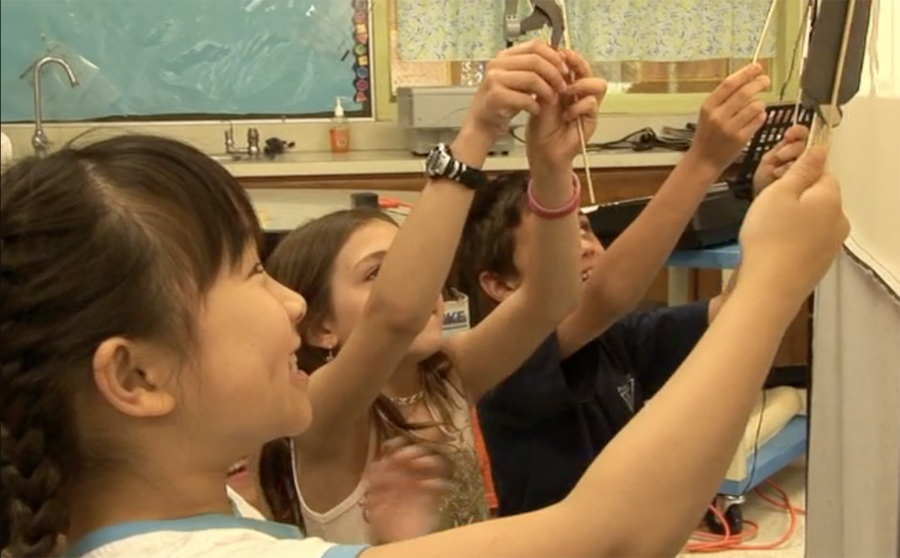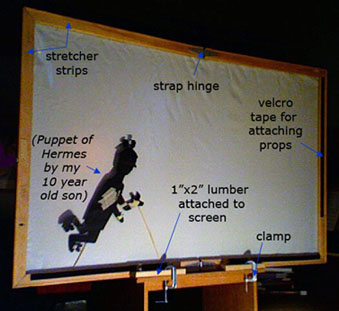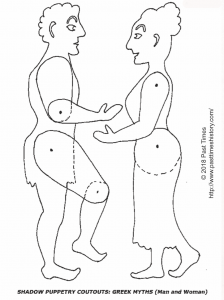
If you want to do shadow puppetry as a class project or for a performance, you need a larger screen and puppets that are big enough to be seen well by the audience (12″-15″). The use of an overhead projector is strongly recommended. It provides a safe, strong and even light and enables you to project background scenes, that can be drawn on transparencies with permanent markers (see Using an overhead projector).
The projector sits on a desk behind the children, who hold the puppets above their heads to prevent casting their own shadows. If you do not have access to an overhead projector, you might be able to find a used projector on eBay.

The screen is attached to either a freestanding frame or a portable frame, clamped to narrow table (above). In Worlds of Shadow, Teaching with Shadow Puppetry David and Donna Wisniewski, who experimented with many types of lights and screens, give detailed instructions. To make a screen they recommend the use of RoscoScreen Twin-White, which is available by the yard (55″ wide) and can be ordered online in theatre supply stores. The Wisniewski book is an indispensable resource for elementary school teachers, and provides in-depth information about techniques, production, rehearsal and performance for different age groups.
Above: Inside of a 56″x36″ traveling screen made of 1 5/8″ stretcher strips (available at online art stores) with RoscoScreen Twin-White attached to the other side with velcro tape.
A note about size
Children often have difficulty sketching out the puppets in a large enough format with appropriately sized limbs that have enough space around the pivoting points. It helps to let them use examples or mannequins, which some children may like to trace and adapt.
 It is easy to go wild about all the possible body parts that can be made to move. Children should realize, however, that they can only move one part at the time (unless there are two puppeteers holding one puppet). Which part of the body should be moveable depends on the role of the puppet. Perseus, for instance, has to use his arm to slay Medusa (his head must turn around too to avoid petrification) while Pandora has to bend over to open the box.
It is easy to go wild about all the possible body parts that can be made to move. Children should realize, however, that they can only move one part at the time (unless there are two puppeteers holding one puppet). Which part of the body should be moveable depends on the role of the puppet. Perseus, for instance, has to use his arm to slay Medusa (his head must turn around too to avoid petrification) while Pandora has to bend over to open the box.
Templates for characters in the printable library are made for puppets 10-11″ high, meant for desk top shadow puppetry. Enlarged to 150% on a photocopying machine, printed on 14″x11″ (A3) size paper, puppets will be big enough to be seen by a larger audience. Make sure the children understand that the body parts on the example shown right are overlapping and should not be cut off. It will cripple their puppet!
Desk top size puppets with a 40″ wide screen for classroom use
For 40″ wide foam board screens that can be used in classrooms with desk top size puppets, check out the blog post How to Make a 40 -inch-wide Screen with Floor Lamp Poles. For light sources check out Supplies.


Thank you for all of the hard work you have put into this website and being so kind to share with us all. What a wonderful thing to do! Thank you.
Thank you very much!
Best site I have found so far on all things concerning Shadow Puppetry. Many thanks for your generosity in sharing your knowledge and the resources!
I appreciate it!!